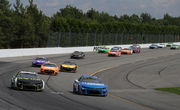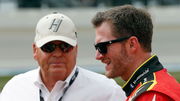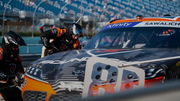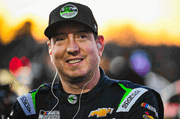

$7.7 billion! That’s the staggering figure NASCAR just raked in from its new media rights deal, making it the most lucrative agreement in the series’ history. With major players like NBC, Fox, Amazon, and Warner Bros Discovery joining forces to cover NASCAR from 2025 to 2031, the excitement is palpable. But it wasn’t all sunshine and rainbows leading up to this deal. Viewership numbers had been on a decline, leaving stakeholders concerned about the sport’s future.
A further decline in 2025 could have jeopardized NASCAR’s negotiating power. It could have even threatened the viability of the sport as a premier racing series. However, the recent Daytona 500 broadcast painted a brighter picture. With a rain-delayed race attracting 13% more viewers than last year, NASCAR seems to be turning the tide. As fans flock back to the screens, let’s explore how these developments might signal a new era for stock car racing.
ADVERTISEMENT
Article continues below this ad
How NASCAR’s new strategy fueled Daytona 500’s viewership surge
For years, NASCAR has been on a mission to reclaim the cultural dominance it enjoyed in the late 1990s and early 2000s. Back then, household names like Jeff Gordon and Dale Earnhardt Jr. transcended the sport, becoming mainstream icons. But as the years rolled on, NASCAR struggled to maintain that same level of public engagement. This, naturally, prompted a shift in strategy. Viewership has been on a decline or remained stagnant for the last few years. For instance, the 2023 Daytona 500 got 8.2 million viewers, whereas the 2024 edition got just 6.0 million viewers.
According to Chief Marketing Officer Peter Jung, NASCAR was doubling down on efforts to attract diverse audiences while positioning its drivers as larger-than-life personalities. “The Netflix series is a good example of how we’re kind of elevating some of these younger drivers… It explains what the sport is all about. It’s way more than cars, you know, making left-hand turns,” Jung told the Wall Street Journal in 2024.
The approach involves a mix of grassroots outreach, media collaborations, and branded content. A prime example? Netflix’s NASCAR docuseries, Full Speed, pulls back the curtain on the sport, giving fans a behind-the-scenes look at stock car racing. The series has amassed 53.1 million views to date and is in the works for a second season to be released in 2025.
Plus, NASCAR is marketing directly to more diverse audiences. It has several programs, such as Drive for Diversity, aimed at fostering inclusivity in the sport. Beyond that, partnerships with organizations like The Trevor Project, The Women’s Sports Foundation, and UnidosUS highlight its commitment to broadening its fan base. These initiatives are not just about representation; they are actively shaping a new era of NASCAR fandom.
.@FoxTV earned 6.761 million viewers for Sunday’s rain-delayed Daytona 500, up 13% over last year’s event that was postponed to a Monday (5.964 million).
🔲 The race peaked at 7.959 million viewers around 2:00pm ET and was the most-watched sports event of the weekend in the U.S. pic.twitter.com/2nOsERu9VV
— Adam Stern (@A_S12) February 19, 2025
What’s your perspective on:
Is NASCAR's $7.7 billion deal a game-changer, or just a temporary boost for the sport?
Have an interesting take?
These efforts appear to be paying off. The 2025 Daytona 500 saw a significant boost in viewership, with 6.761 million fans tuning in despite the rain delay. This is an impressive jump from 2024’s numbers of around 6 million. The race even peaked at 7.959 million viewers, making it the most-watched sporting event of the weekend in the U.S. The 2025 Xfinity race at Daytona, too, attracted 1.8 million viewers—double the 0.9 million from 2024.
Such increases indicate a growing appetite for stock car racing, especially as NASCAR expands its reach through digital and streaming platforms. With NASCAR’s aggressive push into mainstream entertainment and a clear uptick in engagement, the question remains. Can this momentum carry through the rest of the season and beyond?
ADVERTISEMENT
Article continues below this ad
Trending
Did NASCAR’s viewership surge result from careful planning, or did the stars simply align?
The Daytona 500 viewership, undoubtedly, started the 2025 season on a positive note. NASCAR’s senior VP of media and productions, Brian Herbst, believes part of this success comes from how well fans have adapted to unpredictable schedules. “NASCAR fans are almost conditioned to expect fluidity for races due to weather conditions,” he explained. Fox capitalized on the rain delay with compelling real-time storytelling, keeping audiences engaged. “You almost had an in-race preview of what the rest of the race was going to look like,” Herbst added, praising the network’s coverage.
The buzz around the event extended beyond the track. Former President Donald Trump attended, and Captain America star Anthony Mackie took on the role of Grand Marshal, drawing mainstream attention. NASCAR has been actively working to expand its reach beyond traditional motorsport fans. High-profile appearances like these help solidify its place in pop culture.
ADVERTISEMENT
Article continues below this ad
Timing also played a key role. The rain delay pushed the race into prime time. This allowed it to compete with major TV events like the NBA All-Star Game and NBC’s SNL50 anniversary special. Yet instead of losing viewership, NASCAR held strong, demonstrating the effectiveness of its Daytona Speedweek buildup. As Herbst put it, “There’s a drumbeat of programming, content, and racing that leads you up to that big figure on Sunday.”
Whether by strategic planning or sheer luck, everything aligned perfectly for NASCAR’s season opener. Do you think this is a sign of promising times ahead? Let us know in the comments below!
ADVERTISEMENT
ADVERTISEMENT
ADVERTISEMENT
ADVERTISEMENT







Is NASCAR's $7.7 billion deal a game-changer, or just a temporary boost for the sport?